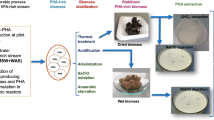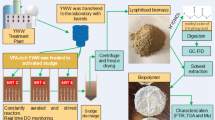Abstract
In this work, volatile fatty acids (VFAs) were used as a carbon source to assess the ability of bacteria present in waste activated sludge (WAS), as indigenous flora, to accumulate polyhydroxyalkanoates (PHA). Acetic acid and propionic acid were used both separately and in combination as feedstock, producing either homopolymer poly(3-hydroxybutyrate) (3PHB) and/or the co-polymer, poly(3-hydroxybutyrate-co-3-hydroxyvalerate) P(3HB-co-3HV). The overall potential to use waste activated sludge as biomass for production of valuable polymers was assessed, and a quality assessment of the as-produced polymers was run, with the extracted polymer being analyzed for properties such as thermal, microstructure and molecular weight. It was found that a blend of copolymers was typically produced, with thermal properties being similar to those reported elsewhere. The overall PHA cell content obtained was 0.29 gPHA gVSS−1.

Similar content being viewed by others
References
Albuquerque M, Eiroa M, Torres C, Nunes B, Reis M (2007) Strategies for the development of a side stream process for polyhydroxyalkanoate (PHA) production from sugar cane molasses. J Biotechnol 130:411–421
Albuquerque M, Torres C, Reis M (2010) Polyhydroxyalkanoate (PHA) production by a mixed microbial culture using sugar molasses: effect of the influent substrate concentration on culture selection. Water Res 44:3419–3433
Arcos-Hernandez M, Pratt S, Laycock B, Johansson P (2013a) Waste activated sludge as biomass for production of commercial-grade polyhydroxyalkanoate (PHA). Waste Biomass Valor 4:117–127
Arcos-Hernandez MV, Laycock B, Donose BC, Pratt S (2013b) Physicochemical and mechanical properties of mixed culture polyhydroxyalkanoate (PHBV). Eur Polym J 49:904–913
Bengtsson S, Werker A, Christensson M, Welander T (2008) Production of polyhydroxyalkanoates by activated sludge treating a paper mill wastewater. Bioresour Technol 99:509–516
Burow LC, Mabbett AN, Blackall LL (2008) Anaerobic glyoxylate cycle activity during simultaneous utilization of glycogen and acetate in uncultured Accumulibacter enriched in enhanced biological phosphorus removal communities. ISME J 2:1040–1051
Choi J, Lee SY (1999) High-level production of poly (3-hydroxybutyrate-co-3-hydroxyvalerate) by fed-batch culture of recombinant Escherichia coli. J Appl Environ Microbiol 65:4363–4368
Chua H, Peter H, Ma CK (1999) Accumulation of biopolymers in activated sludge biomass. Appl Biochem Biotechnol 78:389–399
Coats ER, Loge FJ, Wolcott MP, Englund K, McDonald AG (2007) Synthesis of polyhydroxyalkanoates in municipal wastewater treatment. Water Environ Res 79:2396–2403
Dai Y, Lambert L, Yuan Z, Keller J (2008) Microstructure of copolymers of polyhydroxyalkanoates produced by glycogen accumulating organisms with acetate as the sole carbon source. Process Biochem 43:968–977
Dionisi D, Majone M, Papa V, Beccari M (2004) Biodegradable polymers from organic acids by using activated sludge enriched by aerobic periodic feeding. J Biotechnol Bioeng 85:569–579
Dobroth ZT, Hu S, Coats ER, McDonald AG (2011) Polyhydroxybutyrate synthesis on biodiesel wastewater using mixed microbial consortia. Bioresour Technol 102:3352–3359
El-Hadi A, Schnabel R, Straube E, Muller G, Henning S (2002) Correlation between degree of crystallinity, morphology, glass temperature, mechanical properties and biodegradation of poly (3-hydroxyalkanoate) PHA and their blends. Polym Test 21:665–674
Fei Q, Chang HN, Shang L, Kim N, Kang J (2011) The effect of volatile fatty acids as a sole carbon source on lipid accumulation by Cryptococcus albidus for biodiesel production. Bioresour Technol 102:2695–2701
Gurieff N, Lant P (2007) Comparative life cycle assessment and financial analysis of mixed culture polyhydroxyalkanoate production. Biores Technol 98:3393–3403
Laycock B, Halley P, Pratt S, Werker A, Lant P (2014) The chemomechanical properties of microbial polyhydroxyalkanoates. Prog Polym Sci 39:397–442
Liu HY, Hall PV, Darby JL, Coats ER (2008) Production of polyhydroxyalkanoate during treatment of tomato cannery wastewater. Water Environ Res 80:367–372
Marang L, Jiang Y, van Loosdrecht MC, Kleerebezem R (2014) Impact of non-storing biomass on PHA production: an enrichment culture on acetate and methanol. Int J Biol Macromol 71:74–80
Mengmeng C, Hong C, Qingliang Z, Shirley SN, Jie R (2009) Optimal production of polyhydroxyalkanoates (PHA) in activated sludge fed by volatile fatty acids (VFAs) generated from alkaline excess sludge fermentation. Bioresour Technol 100:1399–1405
Morgan S, Karlsson A, Johansson P, Pratt S (2010) Production of polyhydroxyalkanoates in open, mixed cultures from a waste sludge stream containing high levels of soluble organics, nitrogen and phosphorus. Water Res 44:5196–5211
Nikodinovic J, Guzik M, Kenny ST, Babu R (2013) Carbon-rich wastes as feedstock for biodegradable polymer (polyhydroxyalkanoate) production using bacteria. Adv Appl Microbiol 84:139–200
Pisco AR, Bengtsson S, Werker A, Reis MA, Lemos PC (2009) Community structure evolution and enrichment of glycogen-accumulating organisms producing polyhydroxyalkanoates from fermented molasses. Appl Environ Microbiol 75:4676–4686
Potter M, Muller H, Reinecke F, Wieczorek R (2004) The complex structure of polyhydroxybutyrate (PHB) granules: four orthologous and paralogous phasins occur in Ralstonia eutropha. Microbiol 150:2301–2311
Serafim LS, Lemos PC, Albuquerque MG, Reis MA (2008) Strategies for PHA production by mixed cultures and renewable waste materials. Appl Microbiol Biotechnol 81:615–628
Valappil SP, Misra SK, Boccaccini AR, Keshavarz T (2007) Large-scale production and efficient recovery of PHB with desirable material properties, from the newly characterized Bacillus cereus SPV. J Biotechnol 132:251–258
Valentino F, Villano M, Bertin L, Beccari M, Majone M (2011) Olive oil wastewater as a renewable resource for production of polyhydroxyalkanoates. Renewable polymers: synthesis, processing, and technology. John Wiley and Sons Inc, New jersey, pp 175–219
Yuan Z, Blackall LL (2002) Sludge population optimization: a new dimension for the control of biological wastewater treatment systems. Water Res 36:482–490
Zengin GE, Artan N, Orhon D, Chua AS (2010) Population dynamics in a sequencing batch reactor fed with glucose and operated for enhanced biological phosphorus removal. Bioresour Technol 101:4000–4005
Zhou Y, Pijuan M, Zeng RJ, Yuan Z (2009) Involvement of the TCA cycle in the anaerobic metabolism of polyphosphate accumulating organisms (PAOs). Water Res 43:1330–1340
Acknowledgements
The authors would like to acknowledge the financial support provided from Higher Education Commission of Pakistan through IRSIP under Grant (IRSIP 24 BMS 11) and Dr. Bronwyn Laycock, School of Chemical Engineering, University of Queensland, Australia who supported me in all experiments and provided an opportunity to carry out research work at their University.
Funding
This research was supported by HEC under Grant IRSIP 24 BMS 11.
Author information
Authors and Affiliations
Contributions
This work was carried out by SM while reviewed and supervised by NJ.
Corresponding author
Ethics declarations
Conflicts of interest
The authors declare that they have no competing interests.
Consent for publication
All authors give their consent for publication of this manuscript.
Additional information
Communicated by Erko Stackebrandt.
Publisher's Note
Springer Nature remains neutral with regard to jurisdictional claims in published maps and institutional affiliations.
Rights and permissions
About this article
Cite this article
Munir, S., Jamil, N. Polyhydroxyalkanoate (PHA) production in open mixed cultures using waste activated sludge as biomass. Arch Microbiol 202, 1907–1913 (2020). https://doi.org/10.1007/s00203-020-01912-0
Received:
Revised:
Accepted:
Published:
Issue Date:
DOI: https://doi.org/10.1007/s00203-020-01912-0




